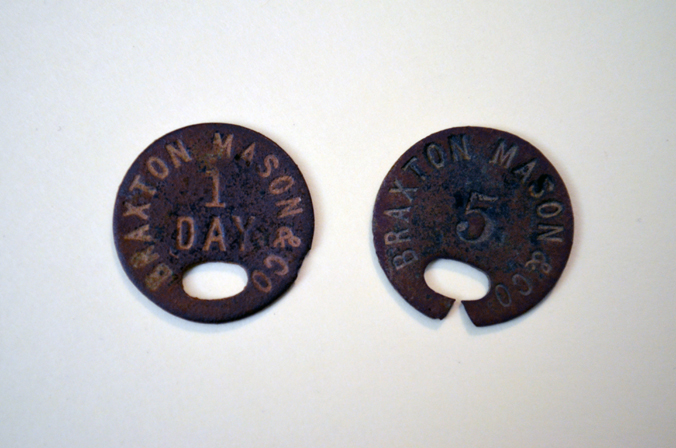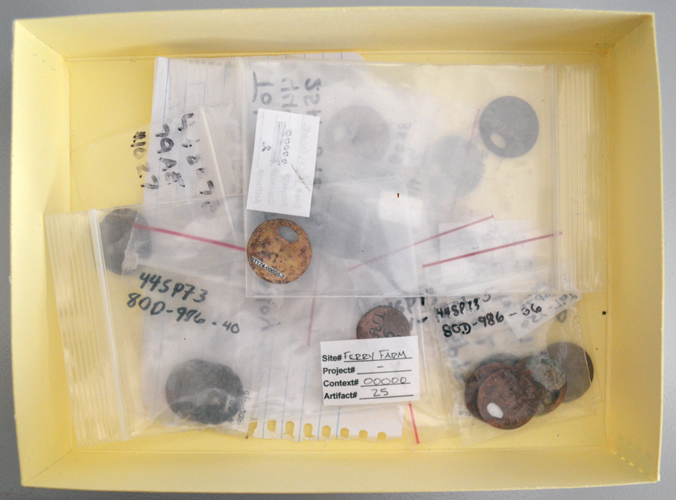During excavations around and under Kenmore’s 19th century portico in the early 2000s, archaeologists discovered several small metal disks. Some disks were significantly corroded but a few still showed markings clearly. They were stamped with the words “Braxton Mason & Co” as well as “1 day” and on another disk “5”. The disks had oval-shaped holes punched through the middle. Over the years, excavations have found a total of 21 disks scattered around Kenmore.
What were these disks? The machine-made nature of both the disks and the stamped words on them suggested they dated much later the 18th century and were more likely from the late 19th or even early 20th centuries. The first clue to their purpose was the holes punched in the middle of each disk, which suggested they were intended to be strung together on a chain or key ring. Though of different shapes and materials, similar artifacts intended to be strung together in the same manner had been excavated at other sites around Fredericksburg, especially on the nearby Northern Neck. In those instances, the artifacts were identified as payment tokens used by workers in the “truck farming” industry. Day laborers were hired to pick produce, which was collected by the bushel-full in trucks and then sold roadside from the same trucks. For every bushel of produce picked, the laborer received a payment token, usually marked with either the amount “1 bushel” or so many pounds. At the end of the day or of the week, laborers lined up to trade in their tokens for payment. As the 20th century progressed, the Northern Neck became a center for the food canning industry, and eventually the small truck farms raised produce almost solely to supply 120 canneries. These canneries started issuing their own payment tokens often stamped with the company name. [1]
For a long time, it was believed the metal tokens found at Kenmore were payment tokens related to truck farming. The thought was that the Howard family, who owned Kenmore from 1881 until 1914, perhaps used the remaining land surrounding the house for a small truck farming operation. The tokens probably had been inadvertently dropped by laborers around the property. On its surface, this seemed a plausible explanation and was added to the canon of Kenmore’s history.
Upon closer inspection, however, there were issues with the truck farming theory. First, Braxton Mason & Co was neither a Northern Neck cannery nor a business anywhere in the Fredericksburg area in the 20th century. Also, the Kenmore tokens were stamped with time increments instead of quantities. Lastly, there was no other evidence of the Howards being involved in truck farming.
Working in the museum field has its definite perks, and one of them is that we have access to a vast network of people who possess an impressive amount of knowledge about a wide variety of topics. Almost all of them love a good mystery! Armed with the name Braxton Mason & Co and a rough date range of 1820 to 1880, I put out a call to museum colleagues in Virginia. Had anyone ever heard of Braxton Mason & Co? Did anyone have any idea what kind of business it was? Within days, I began receiving bits of information and a truly interesting picture began to emerge.
First, a colleague from Petersburg found a tiny reference to Braxton Mason & Co in the Railroad Gazette of 1871. The single sentence stated that the company won the contract to build a portion of the Lynchburg and Danville railroad.[2] Braxton Mason & Co was a railroading firm! But who were the individuals Braxton and Mason? The Acts of the General Assembly of the State of Virginia for 1870 recorded that a Mr. Braxton and two gentlemen named Mason were among a group of 24 investors who formed the Fredericksburg & Northern Neck Railway Company in April. Could this Braxton and one of the two Masons be our guys?
A second colleague found reference to a Carter M. Braxton in the Fredericksburg City Council minutes of 1866. With the Civil War over, the city renewed pre-war efforts to build a railway line to Gordonsville.[3] The project’s engineer was Carter Braxton. The Fredericksburg-Gordonsville Railroad was completed in 1870, just before Braxton Mason & Co was contracted to build the Lynchburg-Danville line. Could Carter Braxton and one of his fellow investors (named Mason) in the Fredericksburg Northern Neck Railroad Company have split off and formed a smaller railway business? At the moment, that seems the likely explanation.
So, that explains what Braxton Mason & Co was but what did it have to do with Kenmore? A third colleague inadvertently came up with a potential answer. In order for Carter Braxton to complete the rail line to Gordonsville, the 1866 city council minutes said, swampy land that was part of the Kenmore property needed to be drained. It was decided the “owners of Kenmore” would be asked to contribute since they would benefit financially from the railway’s construction. The third colleague involved in this research had done extensive work establishing Kenmore’s ownership history. The upheaval of the Civil War kept this history a bit cloudy. Deeds and records of sale simply did not survive. Because of my colleague’s work, however, we know that, in 1866, Kenmore’s owner was Levi Beardsley, a New Yorker who came to Virginia after the war in hopes of finding promising business ventures.[4] As New Yorkers were not popular in the South, he told people that he was actually from Iowa. His secret came to light during a failed political campaign in 1868 and his various business ventures began to crumble. In order to keep Kenmore safe from his creditors, he put it into trust for his wife.[5] The trustee was a man named William Barton.
In 1870, the same year that Braxton Mason & Co began taking contracts on their own, Beardsley and his wife finally gave up and left Virginia. Kenmore was supposedly auctioned off, but it appears that William Barton retained control of the property. Shortly thereafter, Barton rented the house out to tenants. We have never known the identity or number of these tenants.
Is it possible that, while working on the Fredericksburg-Gordonsville Railroad that crossed Kenmore property, Braxton Mason & Co housed their workers at Kenmore itself? Did laborers gather on the house’s portico each week to collect payment for their tokens, some of which were accidentally dropped nearby? It would certainly explain the presence of these perplexing metal disks and fill in the gap of who was living at Kenmore after 1870. Whether this theory can be proven with certainty remains to be seen but, in the end, it’s the investigation that makes it fun…with a little help from our friends.
Meghan Budinger
Aldrich Director of Curatorial Operations
[1] Dodd, Anita L. Day Laborer Tokens: Meaning and Function at Two 18th Century Plantations. 2006.
[2] Railroad Gazette, vol. 3, 1871. Pg. 68. Reference provided by Emmanuel Dabney, Curator, Petersburg National Battlefield.
[3] Minutes of the City Council of Fredericksburg, 1866. Reference provided by Judy Hynson, Archivist, Stratford Hall.
[4] Walker, Travis. Levi A. Beardsley and Family. 2013.
[5] Norman, Gary J. and Edgar R. Hon. Kenmore’s Yankees: The Beardsleys in Fredericksburg. 1996.


